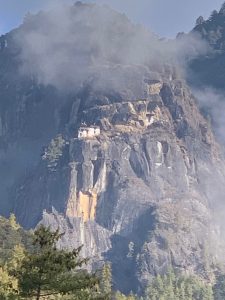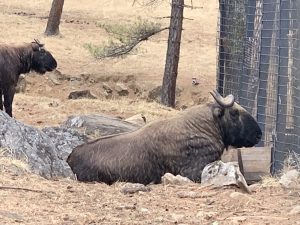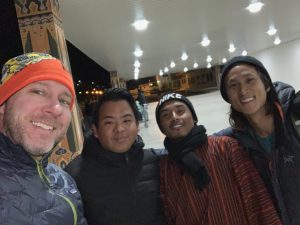Confronting Evil and Cleansing the Soul in Bhutan
Confronting Evil and Cleansing the Soul in Bhutan
Learn how the Bhutanese purify their soul through a variety of rituals
Most Meaningful Experience: Visiting the Tiger’s Nest was awe-inspiring
Top tips
– Visit the Tiger’s Nest Monastery, which was spectacular both inside and out
– Try to see an archery match to experience Bhutan’s national sport in action
– Stroll around town when you get some time alone to chat with locals and understand everyday Bhutanese life.
– Learn about political theories on happiness.https://kdalive.com/bhutan-and-gross…piness-in-action/
Before I arrived in Bhutan, I was interested to discover how the government created happiness, albeit a little skeptical about how it could be applied. I didn’t realize that what I would actually discover was how Bhutanese people create their own happiness and tame mankind’s darkest emotions, which was a more powerful experience altogether.
After a few travelers told us that Bhutan was worth the visit, my friend Dan and I decided to take the one-hour flight from Kathmandu, Nepal to Paro, Bhutan for a four-day tour. Bhutan has a minimum spend requirement for all tourists to the country but as it was the off-season, this was lowered to $200, from $250 per day. This covered all of our transport, food, and accommodation, so we really were treated like royalty!
As we stepped off the plane at the Paro International Airport – one of the most dangerous airports in the world – soaring mountains flanked one side of the tarmac and a terminal building that appeared more like a temple greeted us on the other. The first thing I noticed about the immigration officials was their peaceful smiles and sincere curiosity in the travelers that were passing through.
Bhutan nestles in a rolling valley of the Himalayas, with landscapes blanketed in lush green and dotted with quaint towns, beautiful monasteries and tiny schools. Our guide drove us along the undulating roads and along the sides of cliffs to our first destination – a fort adorned with images of angry demons. I was taken aback – is this how Bhutan greeted tourists? Yet, our guide explained that understanding the evils of mankind was something that the Bhutanese believed needed to be identified and purified. This resonated with me immediately. He went on to explain that if our thoughts, words or actions are laced with greed, envy, anger or ignorance, we will create bad karma for ourselves and others. These were the roots of all evil.
A big festival was in full swing during our visit, so as we explored Bhutan’s monasteries and museums over the next few days, we came across lots of people out celebrating and praying. The festival revolved around reenactments of mythical stories – many about the 3 evil traits above. Young girls dressing in their finest to attract the families of eligible bachelors with pure minds. The most interesting activity was a local archery contest (archery is considered the national sport of Bhutan) and even late at night, we saw archers shooting in the dark!
Everywhere we went, people were spinning large cylindrical wheels known as Noras and chanting “Om Mah Ne Umh”. At one stupa, people were circling it 108 times while others spun wheels and chanted around them. They told us it purified and cleansed their minds. Dan and I immediately noticed the calming effect it had when we focused on what seemed like such a basic activity. I thought it was a powerful exercise, draining your emotions and returning your mind to a peaceful state.
We also visited a fertility temple known as Chimi Lhakhang, which is decorated with images of phalluses that are believed to drive away the evil eye and gossip. One of the monastery’s traditions revolves around striking pilgrims (usually women hoping to have children) on the head with a 10-inch wooden phallus.
Throughout the tour in Bhutan, we were served buffet-style meals that reminded me of Chinese or Indian cuisine. Our guide told us that most tourists had complained that the local dishes were too spicy (the Bhutanese use a lot of chili butter), so the government sent their chefs to Singapore to diversify what they could cook. We still got to taste the traditional chili (a mix of chili, oil, and garlic), which was often used to flavor rice, vegetables and meat. It was also mixed with yak cheese, which was absolutely delicious. One evening we visited a local farmhouse where they prepared dinner before giving us a tour of where they slept, prayed and relaxed.
On our final day in Bhutan, Dan and I decided to run the 2.5-mile route that ascends to the Tiger’s Nest Monastery, which perches on a rocky ledge around 3,000 feet above the Paro Valley. We made it rather fast – just under an hour – compared to others. At the entrance, we left our belongings with the stoic security guard who reluctantly let us in without our guide (who was still an hour behind us), with no phones permitted (there were CCTV cameras everywhere to ensure this was enforced!)
The Tiger’s Nest is filled with golden, half-smiling Buddhas and colorful statues of demons with fierce, lustful, and angry faces. The most awesome demon was riding a tiger – for he was the one who learned to control his anger. I was shocked to see so many of these demons, as I soon understand that the monument was built to rid people of such evil. The builders of this monument wanted to hide the demons away so that they would not reappear. While they were trapped, the monks would come to confront and meditate them away.
The magnitude of it all awakened my soul – how could such a magnificent spectacle be built to rid a person of evil? It must have taken centuries and thousands of souls to accomplish it, with each of those people feeling the same calling. Even reaching the monastery was a challenge, with an arduous hike through nature that was a cleansing of its own sort.
Experiencing the Tiger’s Nest Monastery made me think and reflect on how society needs to let go of these demons. It seems like a simple thing to say “don’t be angry, don’t be envious, don’t be ignorant”. But in practice, it’s much harder to control.
Over the last few years, I’ve undergone my own journey into understanding more about anger, envy, and greed, and found it difficult to rinse those feelings – especially coming from years in Silicon Valley. From the very first temple we visited, however, the Bhutanese confront these emotions head-on that arise from the darkest parts of the soul. I decided that I wanted to learn more and apply this back home, so I did a quick study on it through some books. Learning how to cleanse the soul and mind of these emotions are important tools. But first, acknowledging these emotions, understanding them, and ridding myself of them was what I planned to work on.
To learn about the land of happiness and Tibetan Buddhism, Bhutan is an interesting place to travel to. If you are in the region, it certainly is worth a stop.

Bhutan Demons

Bhutan Tour Meal

Bhutan girls dress

Tiger’s Nest



